Explaining the world one sketch at a time
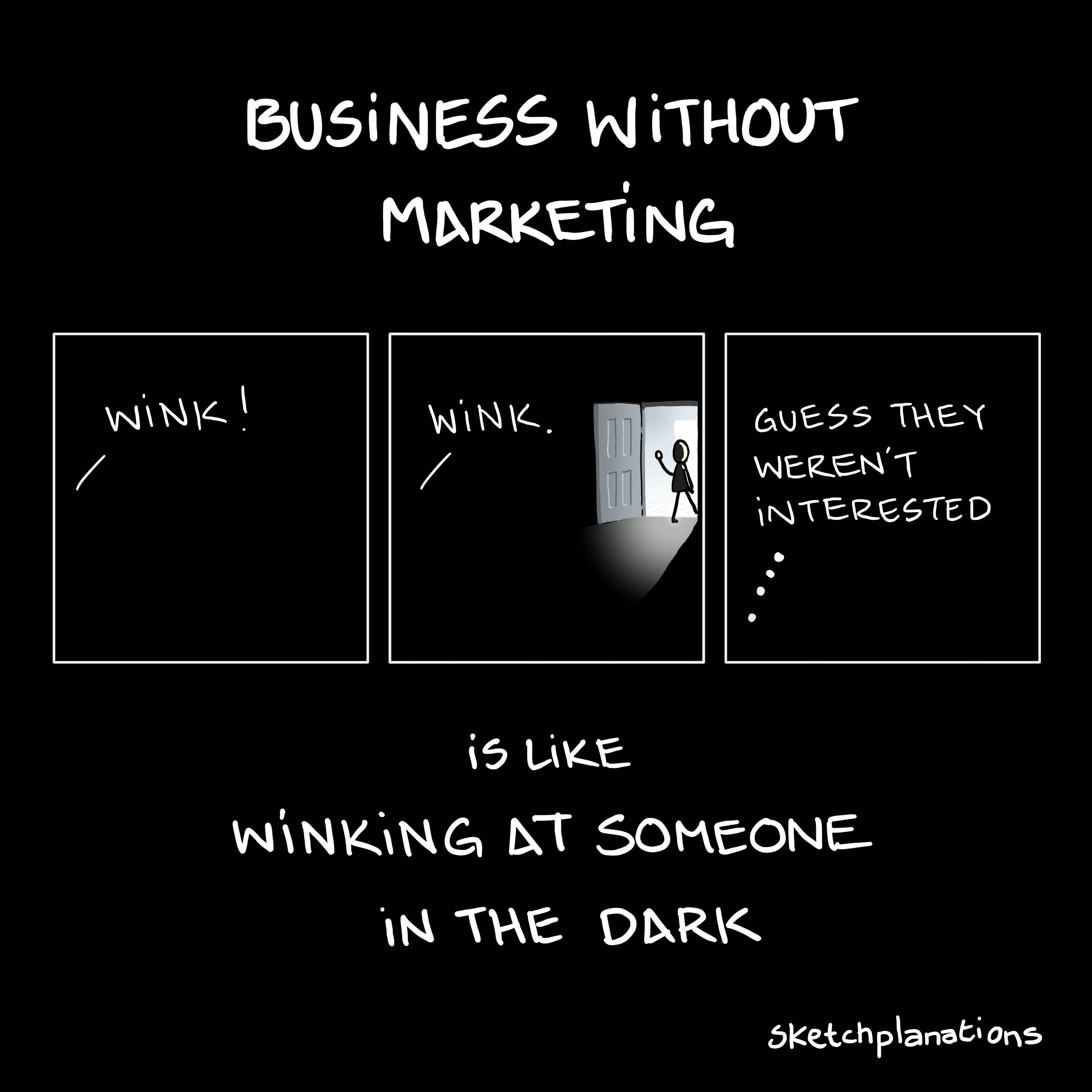
Winking in the dark
An often-quoted adage goes: Doing business without marketing is like winking at a girl in the dark. You know what you're doing, but no one else does. As someone with a background in product development and engineering, I've always cared more about the product than about letting people know that the product exists. But it's an uncomfortable truth that there's no point in having a better product if no one knows about it. More ventures have likely died from not reaching others than from having a lousy solution. This is also why great businesses are built by multi-disciplinary teams—it takes many complementary skills to make a great product succeed. I think the phrase "Build a better mousetrap, and the world will beat a path to your door" is rarely true. Along these lines, if you can think of others who'd find Sketchplanations helpful or who might like my book Big Ideas Little Pictures, please consider sending on a link or your favourite sketch. After all, business without marketing... ;o) The quote is usually attributed with "advertising" instead of "marketing" to Steuart Henderson Britt, a marketing professor and psychologist at Northwestern University. But I couldn't find any verifiable source of the quote to him on the internet, and I prefer it with the more generally applicable marketing, so I went with that. If you know of a trustworthy source for the quote, please let me know! Also see: The rule of 7, the business flywheel…An often-quoted adage goes: Doing business without marketing is like winking at a girl in the dark. You know what you're doing, but no one else does. As someone with a background in product development and engineering, I've always cared more about the product than about letting people know that the product exists. But it's an uncomfortable truth that there's no point in having a better product if no one knows about it. More ventures have likely died from not reaching others than from having a lousy solution. This is also why great businesses are built by multi-disciplinary teams—it takes many complementary skills to make a great product succeed. I think the phrase "Build a better mousetrap, and the world will beat a path to your door" is rarely true. Along these lines, if you can think of others who'd find Sketchplanations helpful or who might like my book Big Ideas Little Pictures, please consider sending on a link or your favourite sketch. After all, business without marketing... ;o) The quote is usually attributed with "advertising" instead of "marketing" to Steuart Henderson Britt, a marketing professor and psychologist at Northwestern University. But I couldn't find any verifiable source of the quote to him on the internet, and I prefer it with the more generally applicable marketing, so I went with that. If you know of a trustworthy source for the quote, please let me know! Also see: The rule of 7, the business flywheelWWW…
Read more…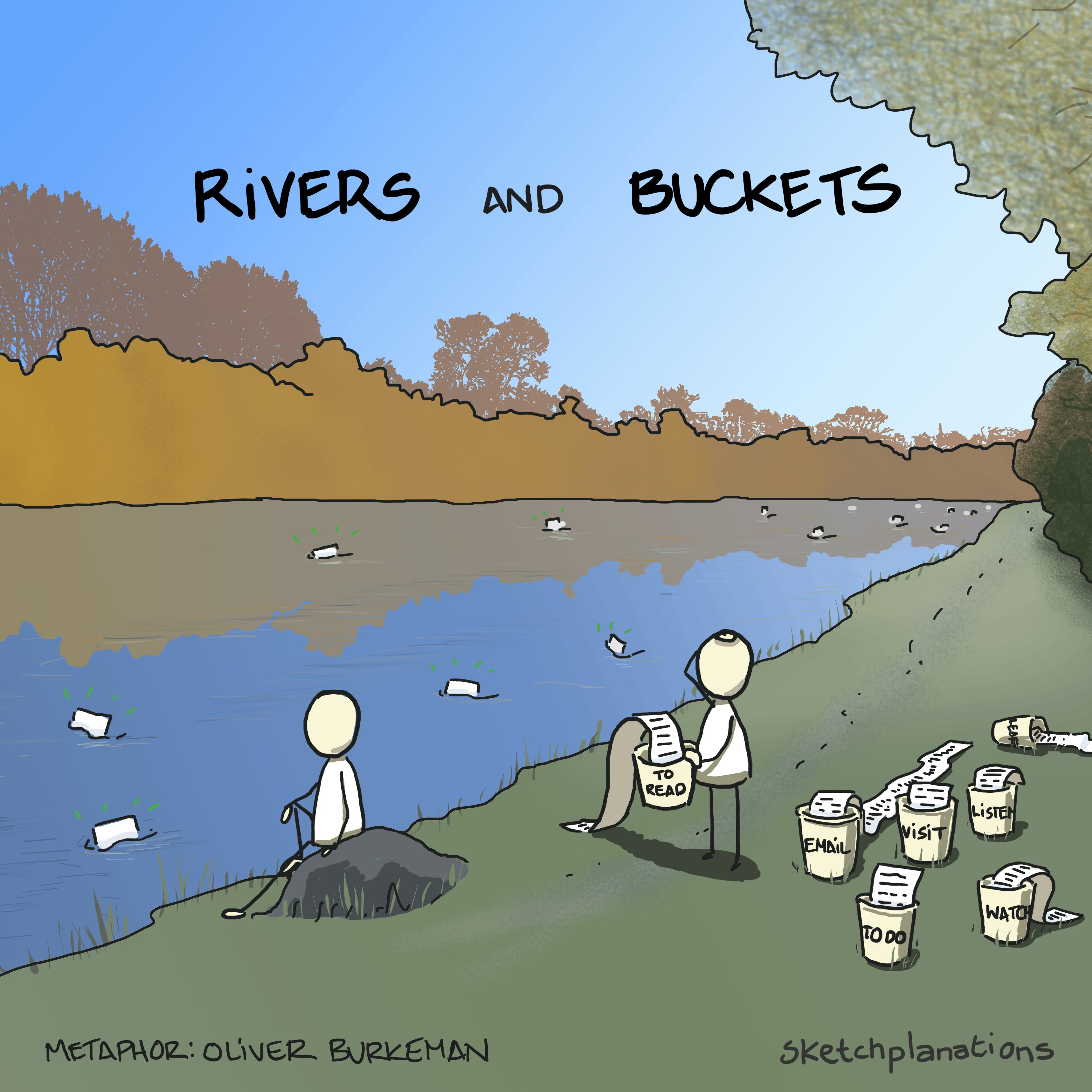
Rivers and buckets
Too many interesting articles to read? Too many places to visit? Too many projects to work on? Too many podcasts to listen to? Too many interesting things to learn? Try thinking of each as rivers, not buckets. Oliver Burkeman shared a beautiful and powerful metaphor to reframe the bucket list of everything we want to do but can't possibly get done. There's an endless stream of books to read, programs to watch, and things you may want to get done. Instead of a bucket list to get through, try thinking of it as a river where attractive options drift by. Rather than feeling pressure to clear out the bucket or tick off all the items, instead, you can choose from the river what interests you in the knowledge that more will always come along. This reframing resonated with me when I considered everything I wanted to read or the emails in my inbox. When you have too many emails, you find you answer the ones that really need answering. There will always be more. Growing up with a scarcity mindset regarding photos, I used to carefully trim each photo I didn't want after a weekend away or travelling. It was a revelation to me to consider selecting the ones I liked instead of worrying about removing every one that I didn't. Maybe you do have to get through everything at work, but this mindset doesn't need to apply to your personal life. Don't beat yourself up. It's impossible to keep up with everything. Consider thinking of areas of your life like rivers, not buckets. Oliver explains rivers not buckets in "Treat your to-read pile like a river". Or listen to Oliver reading the short essay in the Waking Up app. Also see: The four pillars of too much, Lifetime reads, Tsundoku…Too many interesting articles to read? Too many places to visit? Too many projects to work on? Too many podcasts to listen to? Too many interesting things to learn? Try thinking of each as rivers, not buckets. Oliver Burkeman shared a beautiful and powerful metaphor to reframe the bucket list of everything we want to do but can't possibly get done. There's an endless stream of books to read, programs to watch, and things you may want to get done. Instead of a bucket list to get through, try thinking of it as a river where attractive options drift by. Rather than feeling pressure to clear out the bucket or tick off all the items, instead, you can choose from the river what interests you in the knowledge that more will always come along. This reframing resonated with me when I considered everything I wanted to read or the emails in my inbox. When you have too many emails, you find you answer the ones that really need answering. There will always be more. Growing up with a scarcity mindset regarding photos, I used to carefully trim each photo I didn't want after a weekend away or travelling. It was a revelation to me to consider selecting the ones I liked instead of worrying about removing every one that I didn't. Maybe you do have to get through everything at work, but this mindset doesn't need to apply to your personal life. Don't beat yourself up. It's impossible to keep up with everything. Consider thinking of areas of your life like rivers, not buckets. Oliver explains rivers not buckets in "Treat your to-read pile like a river". Or listen to Oliver reading the short essay in the Waking Up app. Also see: The four pillars of too much, Lifetime reads, TsundokuWWW…
Read more…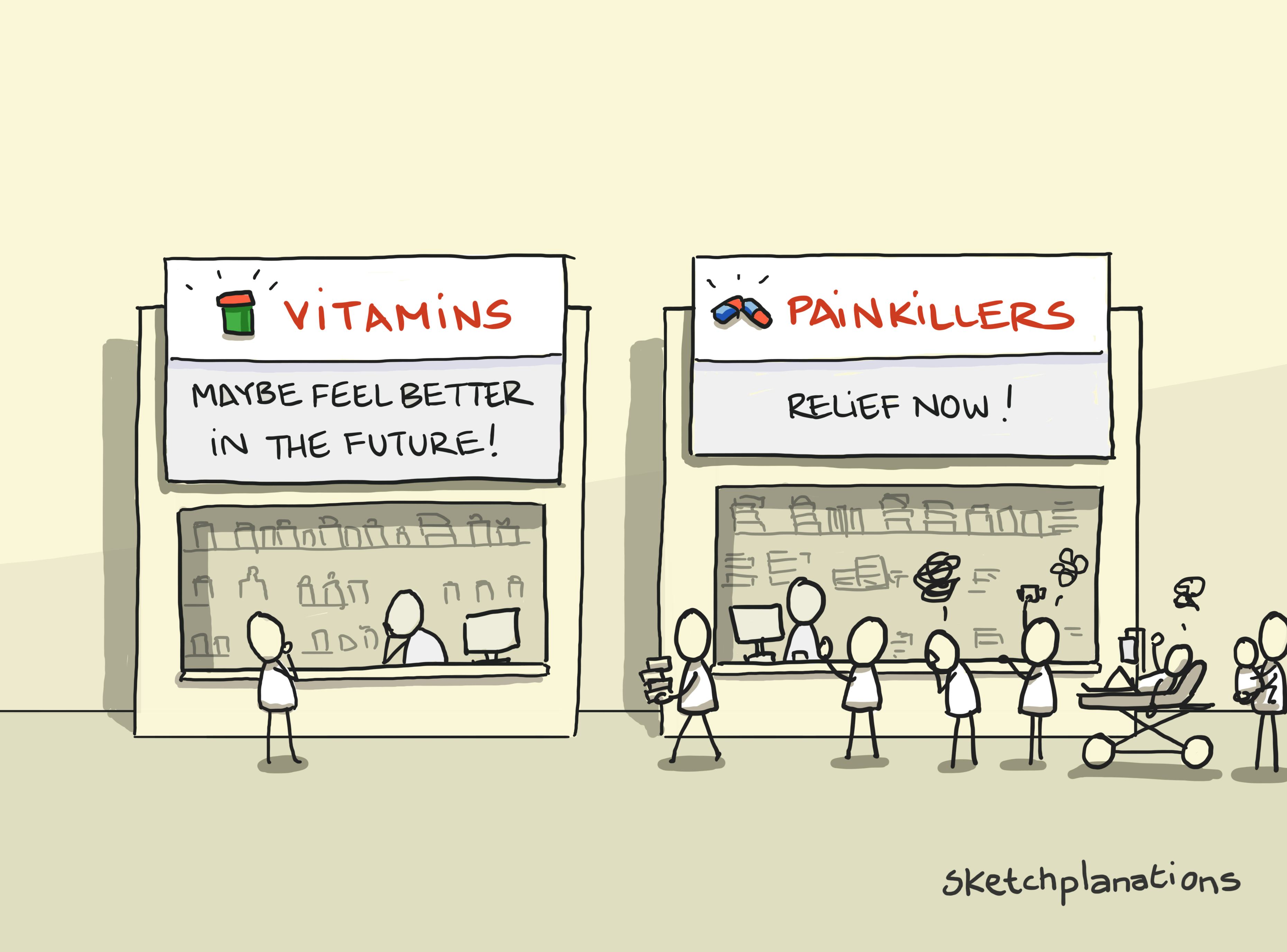
Painkillers and vitamins
Sell painkillers, not vitamins, the classic business advice goes. The vitamin seller aims to help you stay healthy in the long run— to help you avoid future pain and trial by keeping you clear of sickness. However, the painkiller seller has some advantages. If you're experiencing pain right now, a painkiller offers immediate relief. The benefit is instant and tangible. Unlike the vague and uncertain nature of future illnesses, pain is immediate and unmistakable. Knowing if a painkiller worked is easy, as the pain will disappear. It's hard to tell if a vitamin worked. If I don't get sick, was it the vitamins, my sleep, exercise, or, well, anything else that did it? This dynamic can lead to unfortunate consequences. We may prioritise our current needs over future well-being, such as fixing a broken car when it breaks rather than maintaining it. We need help saving money for the future. We tackle the "urgent" and neglect the "important-not urgent." We might overestimate the likelihood of making good choices in the future. In essence, it's easy to downplay future challenges compared to our current predicament. Some examples: implementing security measures vs. fixing bugs looking after your car vs. fixing your car when it breaks down doing daily exercises vs. going to the doctor when you're sick shopping and preparing food vs. ordering takeaway now making a product easier to use vs. making the product compliant preparing fruit to eat later vs. grabbing a cookie now insulating your house vs. putting the heating on now Some see business as selling candy, vitamins, and painkillers. Candy is a treat, but it's easy to live without. Vitamins promise to make life better, but you can do without them. Painkillers are must-haves as they solve an immediate, tangible need. Also see: present bias, tragedy of the commons, the dilution effect, the Shirky principle.…Sell painkillers, not vitamins, the classic business advice goes. The vitamin seller aims to help you stay healthy in the long run— to help you avoid future pain and trial by keeping you clear of sickness. However, the painkiller seller has some advantages. If you're experiencing pain right now, a painkiller offers immediate relief. The benefit is instant and tangible. Unlike the vague and uncertain nature of future illnesses, pain is immediate and unmistakable. Knowing if a painkiller worked is easy, as the pain will disappear. It's hard to tell if a vitamin worked. If I don't get sick, was it the vitamins, my sleep, exercise, or, well, anything else that did it? This dynamic can lead to unfortunate consequences. We may prioritise our current needs over future well-being, such as fixing a broken car when it breaks rather than maintaining it. We need help saving money for the future. We tackle the "urgent" and neglect the "important-not urgent." We might overestimate the likelihood of making good choices in the future. In essence, it's easy to downplay future challenges compared to our current predicament. Some examples: implementing security measures vs. fixing bugs looking after your car vs. fixing your car when it breaks down doing daily exercises vs. going to the doctor when you're sick shopping and preparing food vs. ordering takeaway now making a product easier to use vs. making the product compliant preparing fruit to eat later vs. grabbing a cookie now insulating your house vs. putting the heating on now Some see business as selling candy, vitamins, and painkillers. Candy is a treat, but it's easy to live without. Vitamins promise to make life better, but you can do without them. Painkillers are must-haves as they solve an immediate, tangible need. Also see: present bias, tragedy of the commons, the dilution effect, the Shirky principle.WWW…
Read more…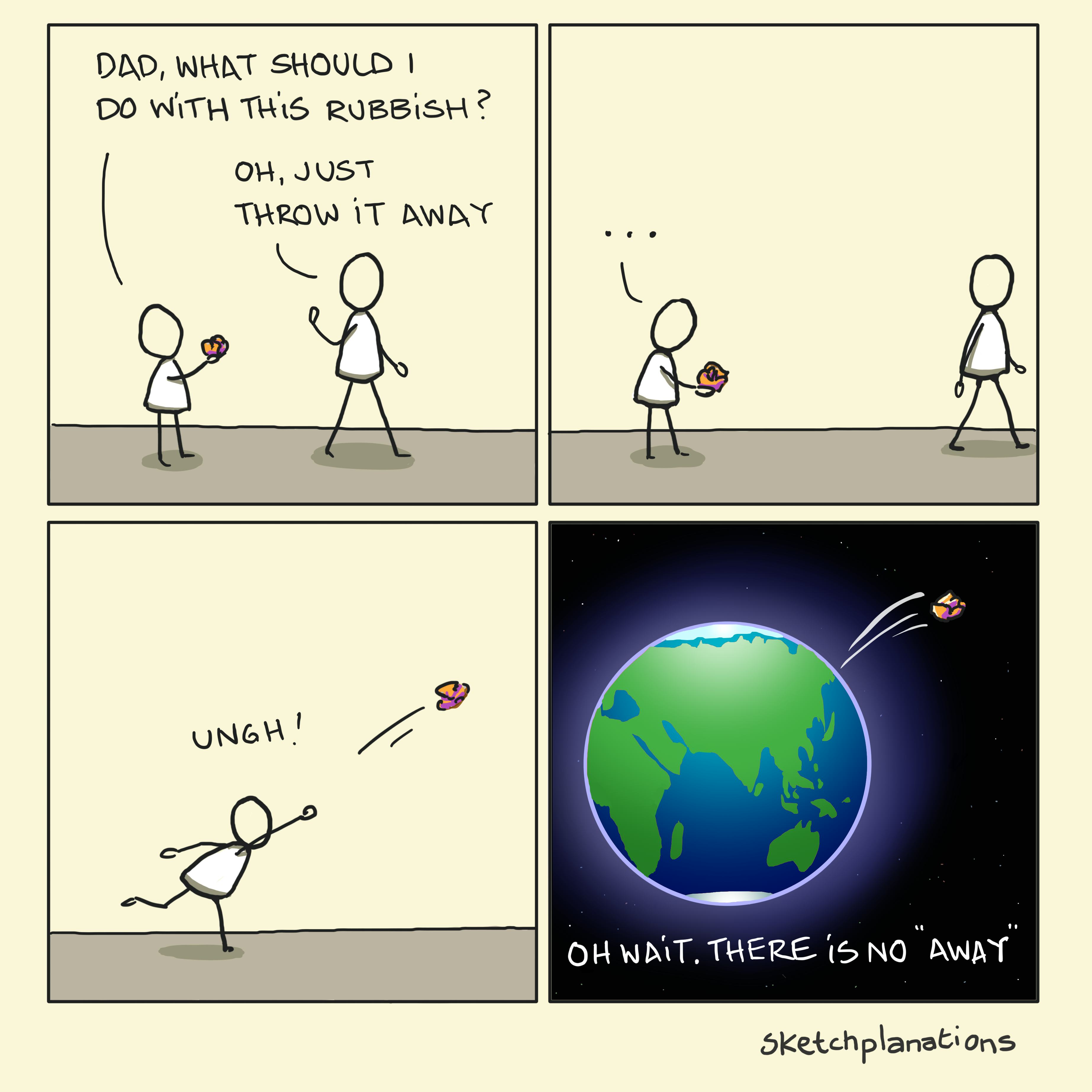
There is no "away"
It's a phrase I always grew up with: you throw rubbish and trash "away" and take what you don't need to "the dump" or "the tip." However, a comment in a nature documentary made me reevaluate: "You can't throw anything away. There is no 'away'." Unless we're throwing a leaf or some grass cuttings back on the lawn, it matters where what we've used ends up. It doesn't go away—it goes somewhere, and eventually, that somewhere will catch up with us. This is why I think "the garbage dump" is better as "the Recycling centre." And we should try to only buy things that we make good use of. And we should try and repair when we can and, if possible, find another home for what we no longer need rather than "dump" it. And why we try to buy recycled products to give a market for those making them. It can be hard work. It's easier and more fun to bring new, shiny things into my life than to find homes for older, less shiny things. But there is no "away." The effort will pay us back in the long run. (I don't mean to get preachy about it, it's just the comment has stuck with me from the moment I heard it) Also see: think cradle to cradle…It's a phrase I always grew up with: you throw rubbish and trash "away" and take what you don't need to "the dump" or "the tip." However, a comment in a nature documentary made me reevaluate: "You can't throw anything away. There is no 'away'." Unless we're throwing a leaf or some grass cuttings back on the lawn, it matters where what we've used ends up. It doesn't go away—it goes somewhere, and eventually, that somewhere will catch up with us. This is why I think "the garbage dump" is better as "the Recycling centre." And we should try to only buy things that we make good use of. And we should try and repair when we can and, if possible, find another home for what we no longer need rather than "dump" it. And why we try to buy recycled products to give a market for those making them. It can be hard work. It's easier and more fun to bring new, shiny things into my life than to find homes for older, less shiny things. But there is no "away." The effort will pay us back in the long run. (I don't mean to get preachy about it, it's just the comment has stuck with me from the moment I heard it) Also see: think cradle to cradleWWW…
Read more…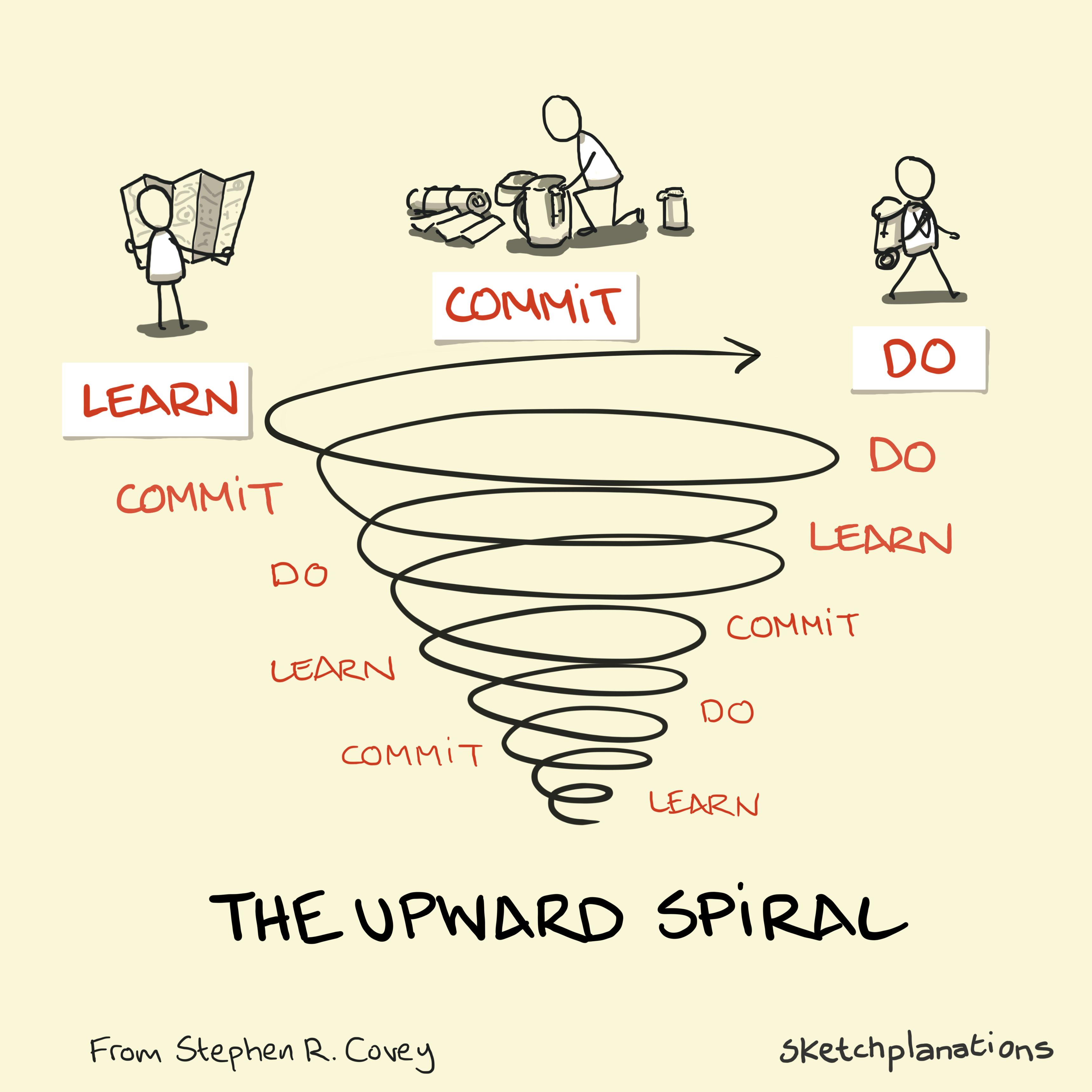
The Upward Spiral
The upward spiral is Stephen R. Covey's simple model of personal growth and change, which repeats the three steps: Learn, Commit, and Do. Of course, we are all doing all of the time. The difference is taking the time and effort to learn from our doing, and deciding to commit to how we want to grow, and deliberately putting it into action. Getting better is in our control. Though it didn't seem like it would take any effort, I've found the commit step to be surprisingly important. For me, "Commit" means actively deciding to make a change and following through with it. It's the difference between finding something intriguing versus deciding that you're going to do something about it. Coupling the "Commit" with getting specific using, for example, implementation intentions can increase the chance of getting on that upward spiral. "Commit" is the mental shift of telling yourself you're going to make a change. Repeating each of the three steps again and again is a simple and guaranteed path to improving at anything we try. Stephen Covey discusses the upward spiral as part of sharpening the saw—renewing, refreshing and recharging ourselves to be the best we can be: "Renewal is the principle—and the process—that empowers us to move on an upward spiral of growth and change, of continuous improvement."
— Dr Stephen R. Covey Also see: sharpen the saw, the express-test cycle…The upward spiral is Stephen R. Covey's simple model of personal growth and change, which repeats the three steps: Learn, Commit, and Do. Of course, we are all doing all of the time. The difference is taking the time and effort to learn from our doing, and deciding to commit to how we want to grow, and deliberately putting it into action. Getting better is in our control. Though it didn't seem like it would take any effort, I've found the commit step to be surprisingly important. For me, "Commit" means actively deciding to make a change and following through with it. It's the difference between finding something intriguing versus deciding that you're going to do something about it. Coupling the "Commit" with getting specific using, for example, implementation intentions can increase the chance of getting on that upward spiral. "Commit" is the mental shift of telling yourself you're going to make a change. Repeating each of the three steps again and again is a simple and guaranteed path to improving at anything we try. Stephen Covey discusses the upward spiral as part of sharpening the saw—renewing, refreshing and recharging ourselves to be the best we can be: "Renewal is the principle—and the process—that empowers us to move on an upward spiral of growth and change, of continuous improvement."
— Dr Stephen R. Covey Also see: sharpen the saw, the express-test cycleWWW…
Read more…
Impossible staircase
The impossible staircase, also known as the Penrose stairs, is an optical illusion of never-ending stairs. Named after its inventor, the mathematician Roger Penrose, who first introduced this concept in the 1950s, the illusion uses multiple, conflicting lines of perspective to trick your eye into seeing the stairs continually rise. I imagined this is what would happen if you visited M.C. Escher's house. Escher made the staircase famous in his drawings Ascending Descending, and Waterfall, after being introduced to it by Roger Penrose, who Escher had inspired to create some impossible shapes. The mindbending Penrose steps also appear in the movie Inception. It took quite a long time to get the perspective right. Ultimately, I used the handy tutorial on drawing the Penrose staircase from the excellent Circle Line Art School. Also see: the ring-segment illusion, the frequency illusion, the moon illusion, and the Hermann Grid, necker cube, and blivet…The impossible staircase, also known as the Penrose stairs, is an optical illusion of never-ending stairs. Named after its inventor, the mathematician Roger Penrose, who first introduced this concept in the 1950s, the illusion uses multiple, conflicting lines of perspective to trick your eye into seeing the stairs continually rise. I imagined this is what would happen if you visited M.C. Escher's house. Escher made the staircase famous in his drawings Ascending Descending, and Waterfall, after being introduced to it by Roger Penrose, who Escher had inspired to create some impossible shapes. The mindbending Penrose steps also appear in the movie Inception. It took quite a long time to get the perspective right. Ultimately, I used the handy tutorial on drawing the Penrose staircase from the excellent Circle Line Art School. Also see: the ring-segment illusion, the frequency illusion, the moon illusion, and the Hermann Grid, necker cube, and blivetWWW…
Read more…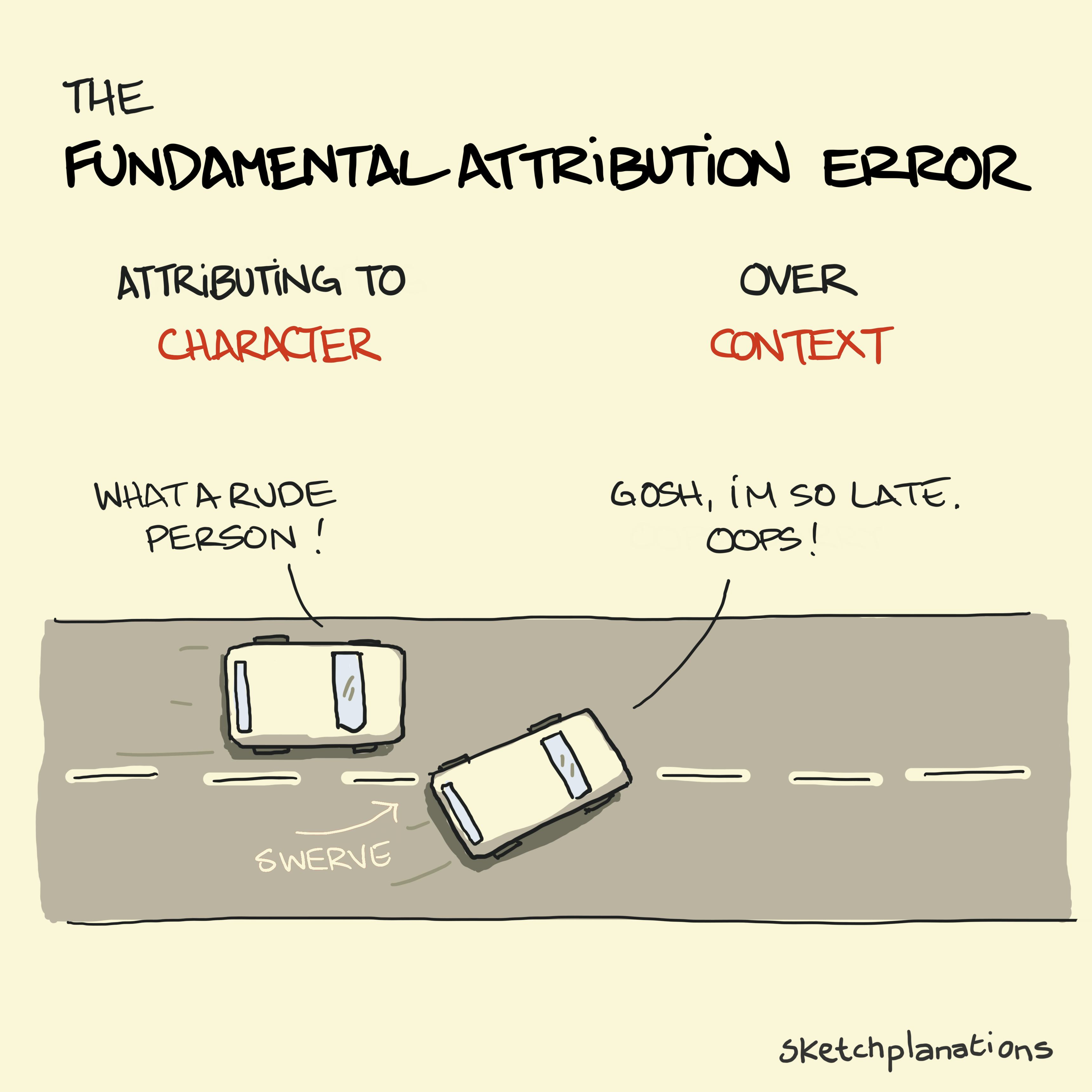
The Fundamental Attribution Error
The fundamental attribution error is the attribution of the source of behaviour to the character and personality of a person above the consideration of context. It's sometimes described as over-attributing causes to disposition over situation. In a classic example, if a driver swerves in front of you suddenly, it's easy to attribute the cause of the behaviour to the driver being a jerk, i.e. to their character. What we may not see is that the driver is late to pick up their kids, was distracted by a challenging conversation they just had at work, and they're worried they've gone the wrong way and are driving an unfamiliar car. If a colleague is late to meet us, we might infer that the person is lazy or disrespectful when, in fact, they may have been held up by a traffic accident, been on the phone with a sick relative, and have had trouble sleeping lately. If we are late for a meeting, well, then it's probably for all sorts of good reasons outside our control. Like confirmation bias, the fundamental attribution error is a big one that can easily colour our interactions with others without us being aware of it. Some ways to minimise it include: Remember that what we see is just a tiny fraction of any other person's life and that we don't see the complete picture. Minimise judgment, particularly around character and personality. Avoid jumping to conclusions. Where appropriate, ask if anything is bothering others. Build empathy for others as you would for yourself. Reflect on the positive things others do. Also see: self-serving bias, attribution bias…The fundamental attribution error is the attribution of the source of behaviour to the character and personality of a person above the consideration of context. It's sometimes described as over-attributing causes to disposition over situation. In a classic example, if a driver swerves in front of you suddenly, it's easy to attribute the cause of the behaviour to the driver being a jerk, i.e. to their character. What we may not see is that the driver is late to pick up their kids, was distracted by a challenging conversation they just had at work, and they're worried they've gone the wrong way and are driving an unfamiliar car. If a colleague is late to meet us, we might infer that the person is lazy or disrespectful when, in fact, they may have been held up by a traffic accident, been on the phone with a sick relative, and have had trouble sleeping lately. If we are late for a meeting, well, then it's probably for all sorts of good reasons outside our control. Like confirmation bias, the fundamental attribution error is a big one that can easily colour our interactions with others without us being aware of it. Some ways to minimise it include: Remember that what we see is just a tiny fraction of any other person's life and that we don't see the complete picture. Minimise judgment, particularly around character and personality. Avoid jumping to conclusions. Where appropriate, ask if anything is bothering others. Build empathy for others as you would for yourself. Reflect on the positive things others do. Also see: self-serving bias, attribution biasWWW…
Read more…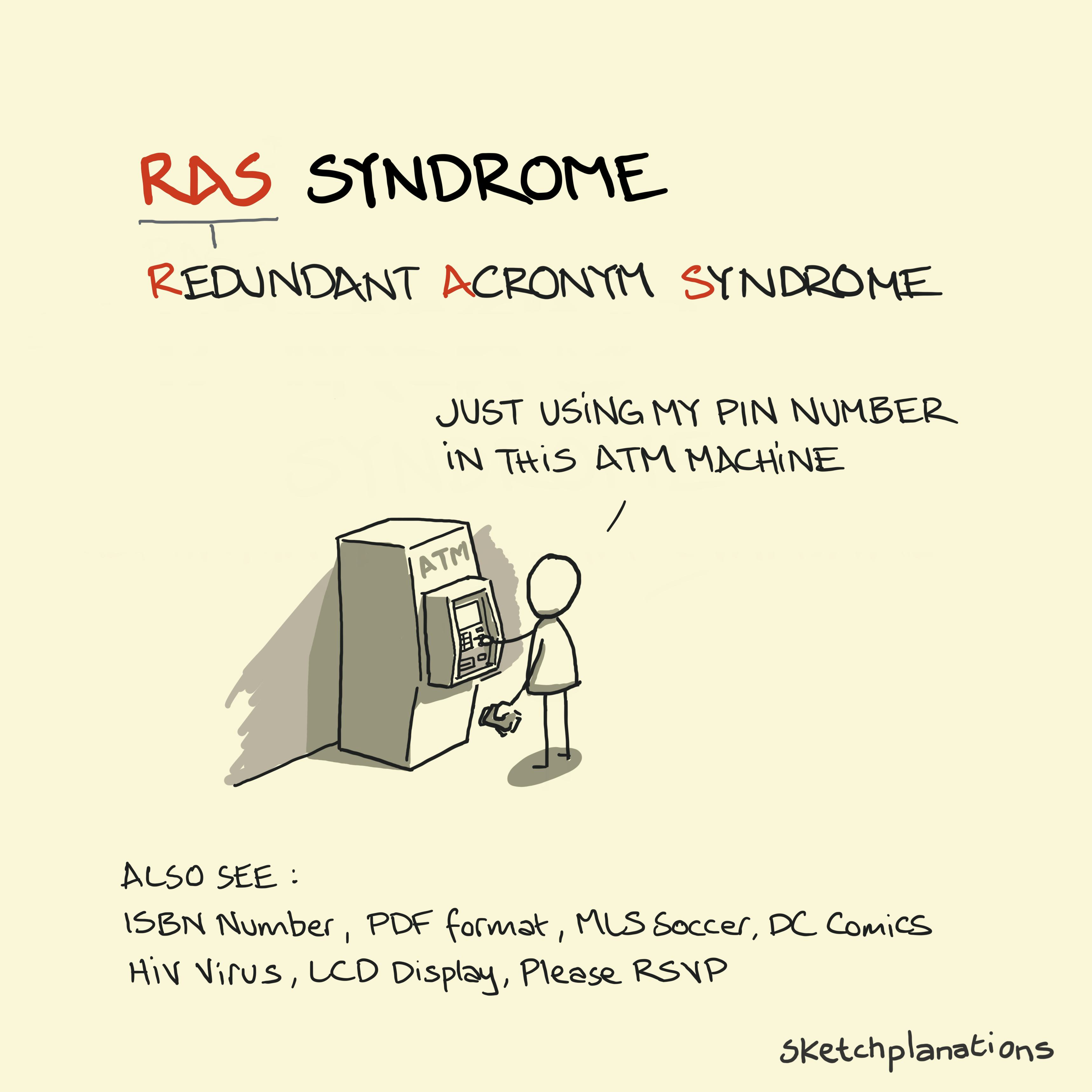
RAS Syndrome
RAS Syndrome is Redundant Acronym Syndrome Syndrome. It's when an acronym is followed by a word that's also part of the acronym. Some examples you may come across: ATM machine - Automated Teller Machine PIN number - Personal Identification Number ISBN number - International Standard Book Number PDF format - Portable Document Format LCD display - Liquid Crystal Display HIV virus - Human Immunodeficiency Virus DC Comics - Detective Comics RSVP please - Répondez S'il Vous Plaît — Reply please MLS soccer - Major League Soccer PAT testing - Portable Appliance Testing While, in principle, the following word is redundant were we to spell out the acronym, that we tend to include it in everyday speech means it's usually serving a helpful function. Quite often, it's clarifying what you're talking about given many people won't know what the acronym actually stands for (see TLAs). By the way, ATM is technically an initialism, while PIN is an acronym. I'd guess you've probably come across RAS Syndrome, too. However, I didn't realise there was a name for it until recently, even though it was coined in New Scientist magazine back in 2001. Also see acronym or initialism, TLAs, Capitonym, pleonasm…RAS Syndrome is Redundant Acronym Syndrome Syndrome. It's when an acronym is followed by a word that's also part of the acronym. Some examples you may come across: ATM machine - Automated Teller Machine PIN number - Personal Identification Number ISBN number - International Standard Book Number PDF format - Portable Document Format LCD display - Liquid Crystal Display HIV virus - Human Immunodeficiency Virus DC Comics - Detective Comics RSVP please - Répondez S'il Vous Plaît — Reply please MLS soccer - Major League Soccer PAT testing - Portable Appliance Testing While, in principle, the following word is redundant were we to spell out the acronym, that we tend to include it in everyday speech means it's usually serving a helpful function. Quite often, it's clarifying what you're talking about given many people won't know what the acronym actually stands for (see TLAs). By the way, ATM is technically an initialism, while PIN is an acronym. I'd guess you've probably come across RAS Syndrome, too. However, I didn't realise there was a name for it until recently, even though it was coined in New Scientist magazine back in 2001. Also see acronym or initialism, TLAs, Capitonym, pleonasmWWW…
Read more…Loading more…